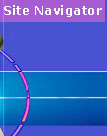|
11.12
- INFLUENCE OF LANGUAGE IN PERCEPTION:
The study has demonstrated that when questions are asked about car accidents,
the answers differed drastically when the words of the question were
changed. The word "smash" was also involved in answers about
the car speed showing that the speed was perceived more than when the
word "going" was used.
11.13
- SELECTIVITY AND ADDITION:
Redundancy plays an important role in noticing the visual data. We don't
always need much data in order to recognise something. Often one can
manage with minimal visual data. The 'blocky' pictures of famous people
can be recognised easily. Our schemata allows us to' fill the gaps'
because we know what should be there. This also involves 'addition'.
Selectivity involves organisation, fore grounding, back grounding, rearranging
etc. Sharpening and levelling is also a part of the perception process.
Sharpening and levelling is more when the understanding is more coherent
and well rounded. Selective perception is based on what seemed to 'stand
out'. This standing out is related to our purposes, interests, expectations,
vast experiences, current demands of the situation, etc.
previous
page
|





